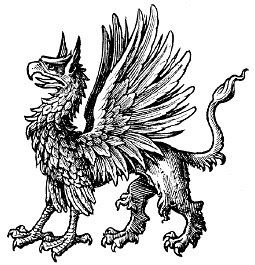 The book the show is based on.
The book the show is based on.According to Adrienne Mayor, an author and classical folklorist, Greek myths may have been inspired by prehistoric fossils. After researching numerous passages from ancient authors, interviewing various paleontologists and analyzing and interpreting ancient art, Mayor concludes that the Ancient Greeks came across prehistoric bones and associated them with strange creatures like the Griffin and Cyclops.
 Elephant...or Cyclops?
Elephant...or Cyclops?The show was so interesting that after it ended I ordered Mayor's book The First Fossil Hunters on Amazon to learn more. The verdict? Although it's needlessly repetitious, Mayor's overall conjecture is fascinating and perhaps even plausible.
One of the things I was surprised to learn is that the scientific community doesn't believe the Ancient Greeks were capable of recognizing prehistoric fossils as bones. I can't fanthom why this would be, and luckily Mayor agrees. She argues that they DID recognize the bones of prehistoric animals, and cites various ancient authors to prover her point. For example, Herodotus reports that in order to win a war against their neighbor Tegea, the Spartans were told by the priestess of Delphi to find and bring home the bones of Orestes (a prince of Mycenae and a relation to the Spartan king Menelaus). Eventually the bones were found on the edge of Tegea, where they were encased in a large coffin measuring almost ten feet long. The Spartans took the remains back to Sparta, reburied them in a lavish ceremony, and won the war.
Although it seems strange to us that the Greeks would think bones that big could be human, Mayor explains that the Ancient Greeks believed heroes like Theseus and Orestes to be three times the size of mortal men! Since most of the prehistoric bones found in Greece belong to huge prehistoric mammals like elephants and rhinosoraus, it's not hard to see why the Ancient Greeks believed in giants and bigger-than-life heroes.
Mayor offers more proof that the Greeks understood fossils with the Monster of Troy vase. This otherwise normal looking column-krater has--for inexplicible reasons--the Monster of Troy portrayed as a weird, white, skull-looking... thing. Mayor insists it is a skull, perhaps a fossil poking out from the side of a cliff. She draws attention to the fact that the teeth are drawn like that of prehistoric animal and that mouth looks like an actual jawbone.
 What is that???
What is that??? She also thinks that the Griffin, which has its origin in Scythia may be based on a dinosaur. Mayor traces the story of the Griffin all the way to the Gobi desert, where nomadic tribes roamed about prospecting for gold. These nomadic Scythians reported to the Greeks that they had seen winged creatures with the body of a lion and the beak of an eagle, and that they fiercely protected the gold dust that fell from the mountains. When Mayor did some investigating she learned that around the area are the well preserved bones of Protoceratops, a dinosaur with a beaked skull and a large crest that could be mistaken for wings. Her side-by-side comparison between the remains of a Protoceratops and a picture of a Griffin is pretty interesting.
 Terrible Lizard or...
Terrible Lizard or... Terrible Griffin?
Terrible Griffin?Although there's no way to prove her theory is correct, it's interesting to think that if they didn't inspire the myths, prehistoric bones at least convinced the ancients that giants and heroes of huge size really existed. At any rate, despite a few editing issues I enjoyed the book. I think I might even use some of the material in my story. :)